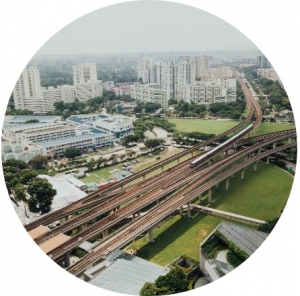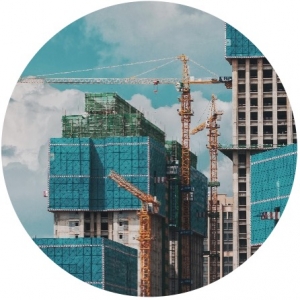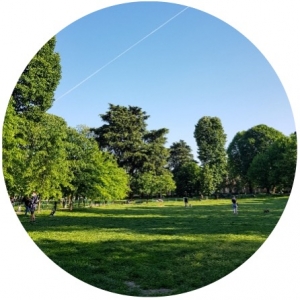Longevity-Ready Environments: Rethinking Physical Spaces for Century-Long Lives
About the 2021-2022 Stanford Center on Longevity Design Challenge topic
Our physical environment helps shape how long and how well we live. The cultural shift brought on by the COVID-19 pandemic shined a light on many aspects of how our health and well-being are affected by our surroundings. In the early days of the pandemic, we got a brief glimpse into improved air quality because so many of the polluters had to shut down temporarily. As many of our usual favorite past times were restricted, people who had access to green spaces flocked to them as a way to boost activity and mental health. We also gained an appreciation for social infrastructure we may have taken for granted before and that became risky to use, such as accessible public transportation and shared spaces.
While COVID-19 may have highlighted the importance of our physical spaces, environmental issues are not new. Additionally, access to healthy environments continues to be limited for people of lower socioeconomic status, and as a result their full potential for long and healthy lives can go unrealized. As we move into the future, with or without COVID-19, we can draw inspiration from the outcomes we saw during the pandemic to innovate better paths to healthy environments for everyone.
For the 2021-2022 Stanford Center on Longevity Design Challenge, we are challenging students around the world to take a look at the physical spaces in their communities and ask: how can we design environments that will lead to healthy long lives for people of all ages now and for future generations?
Why does the physical environment matter?
Many aspects of our physical surroundings affect our health and longevity, including both the built environment and the natural environment. Each of these components affect human health and well-being in important ways. Some examples:

Infrastructure and amenities
Access to infrastructure such as safe and convenient transportation options is important for people who commute to school and to work, and providing options that preserve autonomy is crucial as people age. Similarly, safe and affordable housing options are needed that support individuals at every age, as well as families or living communities that consist of members of multiple generations. Community resources such as recreational, arts, and public safety amenities can also support healthy aging as they help create a robust social structure and tend to be linked to stronger feelings of attachment to a community.1 However, as with transportation and housing options, they often can be less accessible to racial and ethnic minorities and people with lower incomes.

Multigenerational spaces
As the average life span increases and more generations are alive at once, there is an increasing need for spaces that meet two needs: (1) they must be appropriately accessible for everyone from the very young to the very old, and (2) they must encourage interaction between the generations so that the young and old can benefit from each other’s company. Generations United and the Eisner Foundation call such spaces “intergenerational shared sites,”2 which are intentionally designed places that provide services and programs to multiple generations at the same time and foster meaningful relationships between people of different ages.

Construction methods and building materials
Creating environments that are suitable for all the generations that are alive today may bring about opportunities to build or reconstruct the built environment. Construction methods and building materials themselves can have a significant impact on the environment and on human health. For example, some scientists are developing new construction materials that cut down on CO2 emissions compared to current materials, such as bendable concrete.3 There is also opportunity to ensure that structures are built without contaminants and that pollution by airborne particles is mitigated.

Green and outdoor spaces
Spending time in “green spaces” has been shown to have great physical and mental health benefits. For example, according to a study from the Harvard School of Public Health, women living in areas with higher levels of green vegetation had a 12% lower rate of death compared with women whose homes had the lowest level of greenness.4 This is also an area of significant inequality; in the US, poorer neighborhoods have 25% less tree canopy on average than neighborhoods with very few people in poverty.5 Around the world, people of higher socioeconomic status are more likely than people of lower socioeconomic status to have access to urban green spaces, including in African, Asian, and Latin American cities.6

Mitigation of weather extremes
According to a study that examined data from 43 different countries, climate change is responsible for 37% of deaths over a 17-year period that were due to heat.7 As the planet continues to heat up (barring significant reversal of climate change), we will need better, more efficient ways to keep our physical environment at livable temperatures. This is particularly true for people living in low-income and developing regions, who are often more exposed to the effects of climate change. Other weather extremes, such as tropical and winter storms, are growing more intense, and we must innovate so that people of all ages can weather them safely.
These are just some of the examples of how human health and well-being are affected by the physical environment and where we have opportunities innovate to support longer lives. These issues tend to be exacerbated for people who live in low-income or developing regions, so designing affordable and accessible solutions is key.
University students (undergraduate and graduate) of any major or field of study are welcome to submit design idea around the topic, “Longevity-Ready Environments: Rethinking Physical Spaces for Century-Long Lives,” between September 13, 2021 – December 2, 2021. The design may be a product, program, or service, and it will be judged along 5 criteria: impact, originality, feasibility, affordability, and fit to topic. More details can be found on the main Design Challenge website and on the submission site.
1 https://knightfoundation.org/features/community-ties/
2 http://www.sharingourspace.org/
3 https://thehill.com/changing-america/sustainability/infrastructure/541128-what-is-bendable-concrete-and-how-can-it-help
4 https://www.health.harvard.edu/blog/time-spent-green-places-linked-longer-life-women-2017030911152
5 https://www.nytimes.com/interactive/2021/06/30/opinion/environmental-inequity-trees-critical-infrastructure.html
6 https://www.mdpi.com/2413-8851/2/3/67/pdf
7 https://www.nature.com/articles/s41558-021-01058-x
